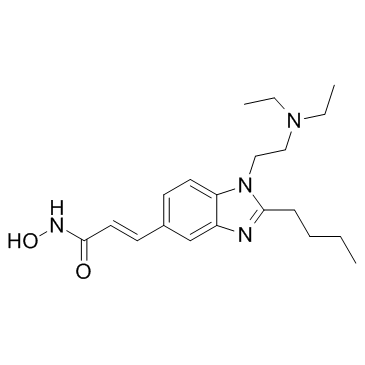929016-96-6
| Name | (E)-3-[2-butyl-1-[2-(diethylamino)ethyl]benzimidazol-5-yl]-N-hydroxyprop-2-enamide |
|---|---|
| Synonyms |
SB939
Pracinostat (SB939) (2E)-3-{2-Butyl-1-[2-(diethylamino)ethyl]-1H-benzimidazol-5-yl}-N-hydroxyacrylamide 2-Propenamide, 3-[2-butyl-1-[2-(diethylamino)ethyl]-1H-benzimidazol-5-yl]-N-hydroxy-, (2E)- SB-939,SB939 Pracinostat SB939,Pracinostat (2E)-3-[2-Butyl-1-[2-(diethylaMino)ethyl]-1H-benziMidazol-5-yl]-N-hydroxy-2-propenaMide |
| Description | Pracinostat is a potent histone deacetylase (HDAC) inhibitor, with IC50s of 40-140 nM, used for cancer research. |
|---|---|
| Related Catalog | |
| Target |
HDAC10:40 nM (IC50) HDAC3:43 nM (IC50) HDAC5:47 nM (IC50) HDAC1:49 nM (IC50) HDAC4:56 nM (IC50) HDAC9:70 nM (IC50) HDAC11:93 nM (IC50) HDAC2:96 nM (IC50) HDAC7:137 nM (IC50) HDAC8:140 nM (IC50) HDAC6:1008 nM (IC50) |
| In Vitro | Pracinostat (SB939) is a potent novel hydroxamate-based inhibitor of HDACs class I, II, and IV, inhibiting the isolated enzymes with a Ki of 19 to 48 nM (class I), 16 to 247 nM (class II), and 43 nM (class IV), but with no activity against the class III isoenzyme SIRT I. SB939 has effects on HCT-116 colon cancer cell line and the HL-60 acute myeloid leukemia cell line, with IC50s of 0.48 μM and 70 nM, respectively. SB939 does not inhibit the proliferation of normal human dermal fibroblasts at concentrations up to 100 μM[1]. Pracinostat (SB939, compound 3) inhibits CYP2C19 with IC50 of 5.78 μM. SB939 shows potent activities against A2780, COLO 205, HCT-116, and PC-3 cell lines, with IC50s of 0.48 ± 0.21, 0.56 ± 0.08, 0.48 ± 0.27, and 0.34 ± 0.06[2]. Pracinostat downregulates JAK and FLT3 signaling in JAK2V617F and FLT-ITD cell lines, and shows synergy in combination with pacritinib. Pracinostat and pacritinib show in vitro synergy on STAT signaling and apoptosis. Pracinostat potently inhibits proliferation of different AML subtypes as a single agent and is synergistic with pacritinib in JAK2V617F or FLT3-ITD AML cell lines[3]. |
| In Vivo | Pracinostat (SB939, 25-100 mg/kg) shows significant dose-dependent growth inhibition of HCT-116 xenografts. SB939 selectively accumulates in tumor tissue. SB939 (50 or 75 mg/kg) exhibits anti-tumor activities in the Apcmin genetic colon cancer mouse model[1]. Pracinostat (25 or 50 mg/kg per day for 21 days) induces significant inhibition of tumor growth (TGI), by 59 and 116%, respectively, in mice bearing MV4-11 xenografts. Pracinostat (75 mg/kg, q.o.d) in combination with pacritinib is efficacious and synergistic in vivo in two different models of human AML. Pracinostat and pacritinib have synergistic effects on AML-induced plasma cytokines/growth factors/chemokines[3]. |
| Cell Assay | Cells are seeded in 96-well plates at a predetermined optimal density, in the log growth phase, and rested for 24 h (adherent cells) or 2 h (suspension cells), respectively, before treatment with SB939. All experiments are done in triplicates for 96 h, with 1% solvent, using either the CyQUANT Cell proliferation assay kit for adherent cells or the CellTiter96 Aqueous One solution cell proliferation kit for suspension cells, in a total volume of 100 μL with SB939 concentrations from 100 μM to 1.5 nM in nine serial dilution steps. IC50 are determined using the XLfit software[1]. |
| Animal Admin | Male ApcMin/+ mice and female C57BL/6 mice are fed a standard rodent diet. Mice with the confirmed mutation, between 16 and 20.5 wk of age, with a positive scoring in the hemocult assay are recruited to the experiment. During treatment, mice are injected i.p. with 40 mg/kg of 5-FU in a volume of 200 μL per 20 g body weight, once daily, for 5 d of treatment, followed by a 9-d recovery period and an additional 5 d of treatment. Treatment with SB939 per oral at 50 or 75 mg/kg once daily is given continuously for 21 d. At the last day of the treatment, the small intestine, caecum, and colon are removed; fixed by multiple injections of 4% PBS-buffered formaldehyde into the gut lumen; cut into segments; and spread flat on a plastic film in a formaldehyde bath. Tumor load is measured in a dissection microscope. Assessment and analysis of the samples are done blinded[1]. |
| References |
| Density | 1.1±0.1 g/cm3 |
|---|---|
| Molecular Formula | C20H30N4O2 |
| Molecular Weight | 358.478 |
| Exact Mass | 358.236877 |
| PSA | 70.39000 |
| LogP | 4.45 |
| Appearance | white solid |
| Index of Refraction | 1.568 |
| Storage condition | -20℃ |
